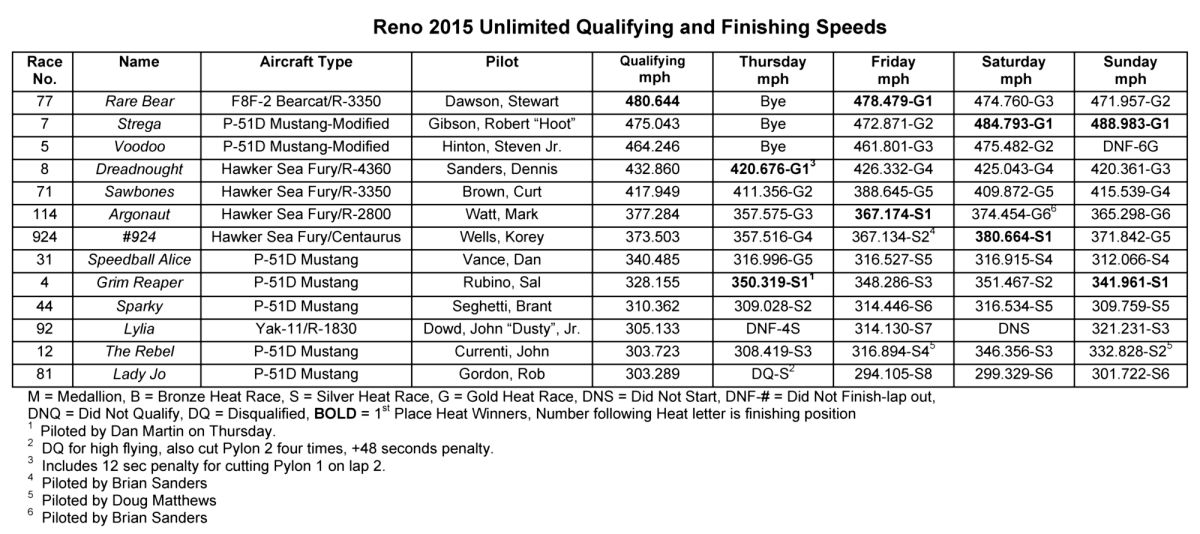
 |
Unlimited Air Racing - Reno 2015
Text and Photos by Dan Whitney
Reno 2015 provided some of the best Unlimited racing seen in a number of years. For the 52nd instance of this classic event there were several new or returning racers, while a few perennial favorites were missing. Thirteen racers were in attendance and grouped so that there was both a Silver and Gold heat each day.
The weather during the early part of the week was a challenge, with smoke from California wildfires severely curtailing visibility on the first day of qualifying. This was followed by a cold front coming through that made it downright cold for most of qualifying, done on Monday, Tuesday and Wednesday. Then it warmed and the clear skies and moderate winds made the rest of the week postcard perfect. As a result the crowds were the best in recent memory and the fans were not disappointed as the racing was also picture perfect, and exciting.
The Big Picture
This year’s field included seven P-51 Mustangs, four Sea Furys, a Bearcat and a Yak. The highly modified P-51s, Strega and Voodoo, were both back and ready for Bear. Strega, featuring a new pilot in the form of Astronaut “Hoot” Gibson, and Voodoo, with more major modifications to its airframe, was again piloted by six time Unlimited Champion Steven Hinton.
Their competition was the Nelson Ezell prepared Bearcat Rare Bear, who appeared to have resolved the stream of past gremlins, and with pilot Stu Dawson ready to take on the competition. The Sanders Brothers of Ione, California again brought three very competitive Sea Furys, led by the R-4360 powered Dreadnought, the R-2800 powered Argonaut and the somewhat unique Centaurus powered stock #924. They were joined by the R-3350 powered Sea Fury Sawbones, flown by Astronaut Curt Brown.
The five “stock” P-51s in the field were joined by an R-1830 powered Yak-11 flown by “Dusty” Dowd. These aircraft gave some spirited performances as they competed in the Silver heat races through the week.
Missing from the competition this year was the Rolls-Royce Griffon powered Mustang P-51XR Precious Metal. Pilot Thom Richard had just finished fueling at a fuel stop while ferrying the airplane to Reno when a fire began in the engine compartment. He shutdown and safely exited the aircraft; however it took the fire department some 20 minutes to extinguish the fire. Although considerable damage was done, there was plenty of talk, and a large contributions bucket in the pits, focusing on getting the popular racer back in the air.
Somewhat surprising was Rare Bear taking top qualifying honors with a speed of 480.644 mph on Monday. Neither of the modified Mustangs elected to make a serious re-qualifying effort at unseating “The Bear”. They were saving their stuff for the coming heat races. They had all achieved their goal of drawing a “bye” for the first day of racing, Thursday, thus improving their chances for a big payoff on Sunday.
“Payoff” is a big issue, as the purses being offered are not sufficient for most teams to be able to afford the cost of an appearance, hence the reduced fields of the past couple of years.
Although there was a lot of hard and competitive racing this year, there were no major engine issues and everyone and everything was able to go home safely at the end of the week.
The Races
The Unlimited course is 8.0851 miles in length. Most of the races are of six laps duration, for a length of 48.01 miles, except on Sunday’s finals, where the Silver is seven laps and the Breitling Gold race is for eight laps, 64.18 miles. Note: all qualifying and race speeds are tabulated at the end of the article.
Thursday – Of course the “Bye” racers were not flying this Gold heat so Dreadnought cruised to an easy win at 420.676 mph, though charged with a 12 second penalty for having cut a pylon. Curt Brown in Sawbones came in second at 411.356 mph. The exciting “race” in the heat was between Sea Fury stable mates Argonaut and #924. Argonaut, piloted by Mark Watt, finished 0.08 seconds ahead of Korey Wells in #924, putting up speeds of 357.575 and 357.516 mph respectively. Dan Vance in Speedball Alice was lapped and finished last with a speed of 316.996 mph.
In the earlier Silver heat Dan Martin took the Mustang Grim Reaper to first place at 350.319 mph, besting the P-51 Sparky by over a minute. Mustangs Sparky and The Rebel were having a good race of their own, finishing at 309.028 and 308.419 mph respectively. “Dusty” Dowd in the Yak-11 Lylia was a DNF while Lady Jo cut four pylons and was disqualified for flying too high.
Friday – The Silver heat launched and recovered eight racers, two Sea Furys, five Mustangs and the Yak. The heat quickly developed into two races within the race: The Sea Furys and Sal Rubino in the Mustang Grim Reaper up front, followed by the remaining Mustangs and the Yak. Argonaut and #924, piloted by Mark Watt and Brian Sanders respectively, duked it out again, finishing first and second and only 0.05 seconds apart at 367.174 and 367.134 mph respectively. This was even closer than they had finished the day before when Korey Wells was flying #924. Grim Reaper came in third at 348.286 mph. In the second part of the race The Rebel and Speedball Alice were 0.63 seconds apart, finishing at 316.894 and 316.527 mph respectively. The Rebel was flow this day by Doug Matthews, who was alternating piloting duties with John Currenti. They were followed by the battling Mustang Sparky and Yak Lylia, who were only 0.55 seconds apart at 314.446 and 314.130 mph. Lady Jo brought up the rear with a speed of 294.105 mph.
Finally we got to see the “big boys” go at it! Ordered by qualifying speeds, Stu Dawson and Rare Bear started on the pole, followed by “Hoot” Gibson in Strega and Steven Hinton in Voodoo. The field was completed by adding the two fastest airplanes from Thursday’s Gold Heat, the Sea Furys of Dreadnaught and Sawbones, piloted by Dennis Sanders and Curt Brown respectively. There was a lot of moving around during the race, but interestingly, they finished as they started. Rare Bear at 478.479 mph, Strega at 472.871 mph, Voodoo at 461.801 mph, Dreadnaught at 426.332 mph, however Sawbones was lapped and ended with a speed of 388.645 mph. It was pretty clear that the guys were feeling each other out, and saving something for Saturday and Sunday’s big events.
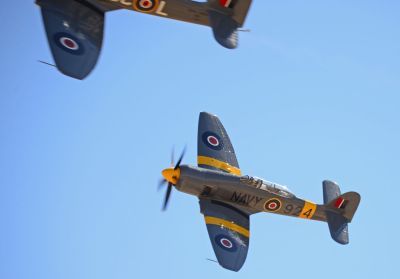 |
| #924 rounding Pylon 2 close behind Argonaut during the Friday Silver heat race. |
Saturday – The Gold heat started in the same order as Friday’s start and finish, with the addition of Brian Sanders in Argonaut, who had bumped up following Mark Watts Friday win in the racer. This was a great race! The top three battled for the lead through lap one, but on lap two Hoot, though a low-time Mustang pilot, passed Voodoo and took Strega to the front, where he stayed, finishing at 484.793 mph. Rare Bear and Voodoo were close on his tail; however they were busy fighting it out, with Voodoo finishing in second place at 475.482 mph and “The Bear” at 474.760 mph, they being only 0.55 seconds apart. Dreadnought finished fourth at 425.043 mph, a safe distance back should any of the leaders break. The other two Sea Furys, Sawbones and Argonaut, finished at 409.872 and 374.454 mph respectively.
The Silver heat started with seven airplanes. Korey Wells in #924 won with a speed of 380.664 mph followed by five Mustangs. These again “paired-up”, with Grim Reaper beating The Rebel with a speed of 351.467 mph versus 346.356 mph, and followed by Speedball Alice and Sparky who were only 0.75 seconds apart at 316.915 and 316.534 mph respectively. They in turn were followed by Lady Jo, at 299.329 mph. Dusty Dowd was a DNS in the Yak.
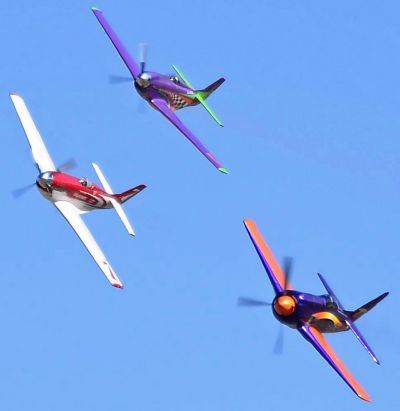 |
| The three highly modified racers coming down the “Chute” and rounding Pylon 4 for the first time on Saturday. Rare Bear is in the lead, followed closely by Strega, with Voodoo in a close third. |
Sunday – The day began with perfect weather for air racing and a large crowd of very enthusiast race fans. All were busy picking and supporting their preferred racer among the top three, knowing that the day would be exciting.
The first Unlimited race of the day was the Silver final, which featured all of the “stock” Mustangs, along with the Yak-11. Sal Rubino in Grim Reaper, with its “souped up” Merlin, won the race, which appeared much like a parade. He ran 341.961 mph, followed by Doug Matthews in The Rebel at 332.828 mph and Dusty Dowd in the Yak Lylia at 321.231 mph. Following them were the Mustangs of Dan Vance in Speedball Alice, Brant Seghetti in Sparky and Rob Gordon in Lady Jo rounding out the field with finishes of 312.066, 309.759 and 301.722 mph respectively.
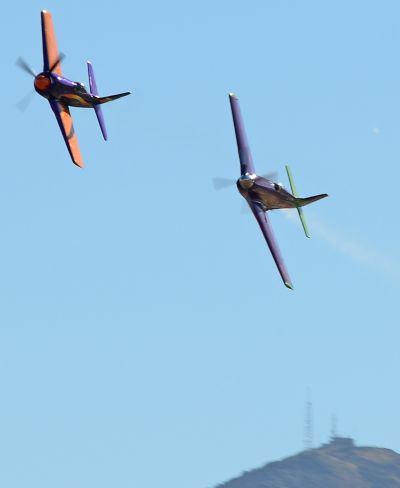 |
| Voodoo leading Rare Bear coming toward Pylon 2 during Sundays Breilting Gold race. Note the oil breather smoke trailing Voodoo. |
The field for the eight lap Breitling Gold Unlimited Final featured the three highly modified airplanes, Strega, Voodoo and Rare Bear in their Saturday finishing order followed by four Sea Furys, each with an entirely different type of engine. Not something that is seen every day.
The racers “came down the chute” and with the call of “Gentlemen, you have a race” by the pace and safety pilot Steve Hinton, Sr., they were off. Stu Dawson in Rare Bear surged into the lead, though Hoot Gibson in Strega and Steve Hinton, Jr. in Voodoo both quickly overtook him. They were really moving, it was announced over the PA system that the first lap speed was over 503 mph! Strega stayed in front while Steve battled with Stu for second, going back and forth until the sixth lap when Steve called a Mayday and left the fray. He had been porting oil smoke from a breather and was fighting high coolant temperatures. Steve joined up with his dad in the pace plane and made a beautiful landing on the back runway. At the finish it was Strega at 488.983 mph in first and Rare Bear in second at 471.957 mph. Both Strega and Rare Bear fans were overjoyed as it had been years since either had had this kind of success.
With all of the excitement up front the trailing Sea Furys took it easy. Dennis Sanders in Dreadnaught finishing third at 420.361 mph, followed by Curt Brown in Sawbones at 415.539 mph. Fifth place was taken by Korey Wells piloting #924 at 371.842 mph while Mark Watt followed up in Argonaut at 365.298 mph. All of the Sea Furys were lapped by Strega, Argonaut twice!
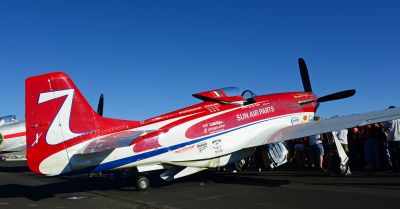 |
| Strega in the Winners Circle following Sundays Breitling Gold race, not looking too bad, although showing signs of some oil leakage, while the lack of exhaust stains says the engine was running great. |
The Racers
The following descriptions of each airplane are given in the order in which they qualified. See the table at the end of this report for speeds and placement in all of the Unlimited Heats.
#77 Rare Bear, the highly modified F8F-2 Bearcat powered by a Wright R-3350 was again flown by Stu Dawson and supported by crew chief Nelson Ezell. During a practice run on Sunday, prior to qualifications, a carburetor diaphragm had ruptured, so the racer stood down while the spare carburetor was flown up from Texas. Nelson reported that he had resolved the previous tendency for the engine to have inconsistent fuel mixtures. He found that when the racer’s R-3350 was built the Accessory/Supercharger section had come from the fuel injected version of the R-3350. He revised the fuel injection nozzle so that it is now located as Wright intended for non-injected engines. Otherwise, the engine is essentially the same as last year, although it is turning the propeller that was mounted on Sea Fury #232 last year.
The airplane ran well all week with cylinder head and induction temperatures right where they should be. After Saturday’s race all eighteen cylinders were checked for compression and there were no issues, so ready to go racing again.
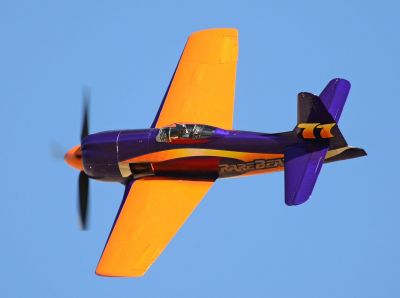 |
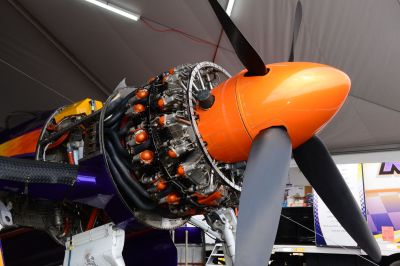 |
| Rare Bear rounding Pylon 2 during Sundays Breitling Gold Heat. | Rare Bear R-3350 uncoweled. Ain’t she purddy? |
#7 Strega, a highly modified P-51D Mustang competed this year with its Allison rodded Merlin having been prepared by Vintage V-12s, which required a new crankcase and nose case, and flown this year by ex-Shuttle Astronaut “Hoot” Gibson. Although Hoot was somewhat new to the Mustang he performed flawlessly, flying a beautiful and consistent path on the course. He also showed his competitive spirit by aggressively positioning the airplane, taking the lead and fending off challengers. The only apparent issue for airplane was during the Saturday heat race when an exhaust nozzle cracked and the adjacent cowling was burned. This was easily repaired and the racer flew flawlessly on Sunday.
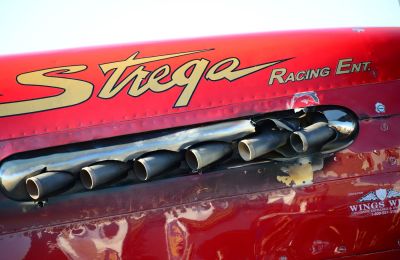 |
| Strega cowling was damaged when a section of an exhaust stack blew out during Saturday’s Gold Heat. A whole new set of exhaust stacks were procured, a new shroud fitted, and she was ready to go again. The replacement stacks did not have the same sharp angle, hence gave slightly less exhaust thrust. |
#5 Voodoo, a modified P-51D similar to Strega and also powered by an Allison rodded V-1650 Packard Merlin. After winning the Gold for the past two years the racer was back with still more racing refinements by Pilot/Mechanic Steve Hinton and Master Crewchief Bill Kerchenfaut and their skilled crew. In an effort to further reduce trim drag on the airframe they changed the angle of incidence of the wing and elevator to zero, built a new inlet to the coolant scoop as well as new fairings and repainted the racer. The most obvious change was that the racer was no longer #5, but Roman numeral V, and the paint scheme featured orange were there use to be yellow. In total the off-season changes made to the airframe reduced the weight by 125 pounds. Pilot Steve Hinton, who has raced and won in both Strega and Voodoo, says the two airplanes now handle and fly very similar to each other, a significant improvement over how it had been three years ago. He also noted that he had been asked to test fly Strega a week before Reno, so was able to compare the present configurations of both aircraft at Takeoff power. In the past Strega had been 10 mph faster at this condition, and now there was no difference.
After a check flight prior to qualifying the crew found that the new manufacture coolant header tank was cracked. This required removal of the propeller to gain access, and then an overnight weld repair to the tank. They also had a bad fuel boost pump, so the coolant radiator/doghouse had to be removed for access. A lot of work to resolve a couple of otherwise minor issues.
After the Saturday race there were no issues, however the team elected to perform a “dawn patrol” flight early Sunday morning. It was a good thing, as the “exhaust” magneto was found to be dead. This was replaced and they were ready to go for the Breitling Gold!
It was not to be this year. During the race the ground crew was monitoring the engine conditions and noted that coolant temperatures were becoming uncontrollable. At the same time blue smoke could be seen coming from the engine breather, suggesting deteriorating conditions within the engine. On lap six, of the eight lap race, Kerch recommended backing off and landing as soon as possible. Steve did and was able to land and return to the pits. Post race inspection found that again the coolant header tank had cracked, with the resulting loss of coolant and high temperatures.
The crankcase blowby at high power suggests the piston rings were not up to the task when running at 142 inHgA and 3,600 rpm as Stevo did on Sunday coming down the chute. Further investigation will be required to find the cause of the cracked header tank and any other issues with the engine. The engine is being torn down for inspection.
 |
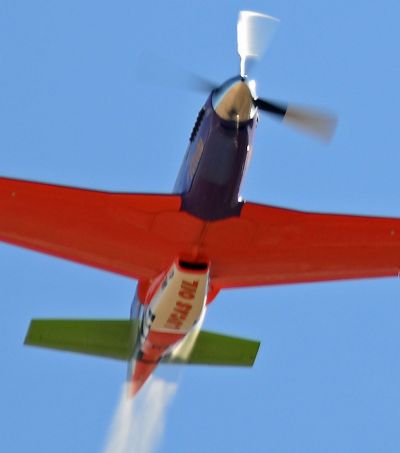 |
| Voodoo with its wing reset, a new paint job, and now identified as #V. Photo taken during the Friday Gold heat race. Note the yarn “yaw” indicator is right on centerline. Good piloting! There is also a condensation “streamline” showing at the wing root, very smooth. Significantly, the radiator scoop/door is nearly fully retracted, but there is some breather oil showing. | Voodoo coming “down the chute” going into the first lap. With the engine at 142 inHgA the breather was spewing copious amounts of oil from the leaking piston rings. |
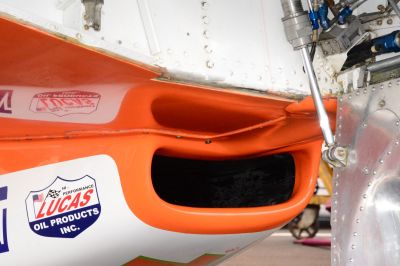 |
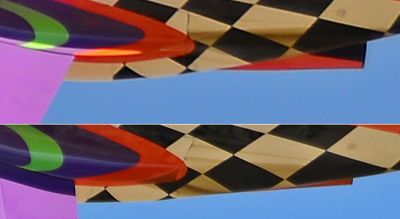 |
| Voodoo’s new coolant air scoop. Results suggest the opening may a little too small for the amount of cooling needed at race power. | Top is Voodoo’s radiator door and crankcase breather on Sunday compared to how they were during the first race on Friday. Both days a lot of oil was venting from the breather, and it’s visible in the Sunday image. The vent is actually under the extended fairing. The greater opening of the radiator door slowed the racer, and still the engine was getting hot. |
#8 Dreadnought, a Sea Fury T.Mk.20, re-powered with a Pratt & Whitney R-4360, piloted by Dennis Sanders. This big and heavy airplane will never be able to run as fast as the modified Mustangs and Bearcat, but it is still very fast and dependable. As a result Dreadnought often finishes in the money when one or more of the leaders have problems. Back in 1986 Dreadnought set a new qualifying record at 452.737 mph, so qualifying at 432.860 mph this year did not show the full potential of the racer. That was shown in the Thursday heat race when Dennis cut a pylon and was assessed a 12 second penalty. Correcting his winning speed of 420.676 mph for the penalty shows that the racer was actually running 455.607 mph! True to form, when Voodoo pulled out on lap six in the Breitling Gold Dreadnaught was in position and took third place at 420.361 mph.
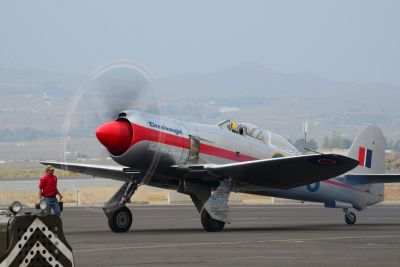 |
| Dennis Sanders clearing the plugs on Dreadnought after returning from his Monday qualifying run of 432.860 mph. Note the heavy smoke and poor visibility due to California wildfires. |
#71 Sawbones, is a Wright R-3350-26WA powered Sea Fury FB.11, flown by Shuttle Astronaut Curt Brown. During Fridays Gold Heat Sawbones let the “big” boys duke it out up front and saved his stuff, in fact he was lapped by both Rare Bear and Strega on the home stretch of their final lap. Curt picked up the pace for the rest of the week, running fourth in the Breitling Gold with a speed of 415.539 mph.
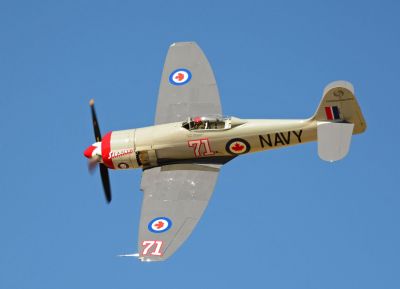 |
| R-3350 powered Sawbones, piloted by Curt Brown during Saturday’s Gold heat. |
#114 Argonaut, a Sea Fury FB Mk.11 powered by a Pratt & Whitney R-2800-CB3, and flown by Mark Watt and Brian Sanders. Within the Sanders’ brothers stable of Sea Furys this airplane is extremely competitive with their stock Centaurus powered #924. In both the Thursday and Friday heat races Argonaut and #924 had the tightest races and finishes, Argonaut winning by 0.08 seconds on Thursday and #924 by 0.051 seconds on Friday. Argonaut won this heat race at 367.174 mph, bumping the racer up into the Saturday Gold heat. This marks at least the third year where these two racers have finished within a fraction of a second of each other numerous times. This makes for some really fun racing, for both the pilots and fans.
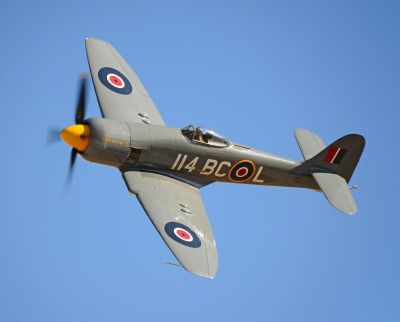 |
| Argonaut is the first Sea Fury to be powered by the mighty Pratt & Whitney R-2800, making it a very desirable update of the original Centaurus powered version. The Sanders brothers have been flying it for about five years. It has proven to be a reliable and very competitive racer. |
#924 is a Sea Fury T.Mk.20 powered by an original Bristol Centaurus engine, flown primarily by Korey Wells, who qualified the racer at 373.503 mph. #924 finished behind Argonaut on Thursday, and then on Friday, piloted by Brian Sanders, again finished behind Argonaut; both times by a fraction of a second. Korey was back in the airplane on Saturday and won the Silver heat with a speed of 380.664 mph, besting his qualifying speed of 357.516 mph. With this win Korey took the airplane into the Sunday Breitling Gold where he beat Argonaut by 1.25 seconds.
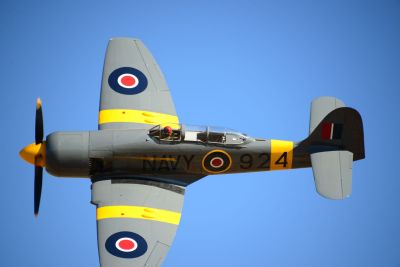 |
| A Sea Fury powered by the original Centaurus is a rare bird to see these days, particularly racing. Here #924 is rounding Pylon 2 in the Sunday Breitling Gold race piloted by Korey Wells. |
#31 Speedball Alice, a stock P-51D Mustang flown by Dan Vance. Qualified at 340.485 mph and turned in heat times of 316.996, 316.527, 316.915 and 312.066 mph respectively on the four days of racing. This was not as lackluster as it might appear as on Friday she bested Sparky and Lylia, running at 314 mph and on Saturday beat Sparky by 0.66 seconds, 0.38 miles per hour, a very close race.
 |
| Speedball Alice piloted by Dan Vance was a steady performer all week. |
#4 Grim Reaper, a stock P-51D Mustang, but fitted with a race tuned Merlin. Piloted primarily by Sal Rubino, his crew included Dan Martin and Mike Barrow, both of whom have had extensive experience with the old #4 racer Dago Red. Tweaks to the Merlin included more aggressive cams, taken from boat racing, advanced timing and automotive style ignition harnesses. Engine speed was maintained at the stock 3,000 rpm, but still the changes provided enough power that the beautiful airplane was able to run in the 350 mph range, faster than any of the other “stock” Mustangs, although he qualified at 328.155 mph. In the course of the week Sal won the Thursday Silver heat at 350.319 mph and the Sunday Silver heat at 341.961 mph. A very good showing for the first time racing this newly restored Mustang.
 |
| Grim Reaper piloted by Sal Rubino rounding Pylon 2 during Sunday’s Silver heat. He went on to win at 341.961 mph, besting four other stock Mustangs and the Yak-11. |
#44 Sparky, a stock Merlin powered P-51D flown by Brant Seghetti. Brant qualified this colorful racer at 310.362 mph, which was less than his last years qualifying speed of 329.638 mph, which in turn was some 30 mph slower than the year before. On Friday Sparky had a close race with Dusty Dowd in the Yak-11 Lylia, whom he edged out with a speed of 314.446 versus 314.130 mph. On Saturday Sparky had another close heat, losing to Speedball Alice, who turned 316.915 mph, with a speed of 316.534 mph. Good racing!
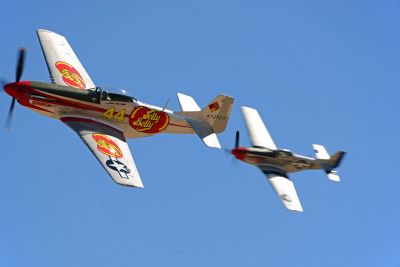 |
| Sparky has the inside line on The Rebel during Thursday’s Silver heat. They finished 2nd and 3rd respectively with speeds of 309.028 and 308.419 mph. |
#92 Lylia, a Russian Yak-11 fitted with a Pratt & Whitney R-1830-54. This model engine is from the late model B-24 bombers and incorporates a number of upgrades and improvements learned on earlier models of this engine. This was the first time racing Lylia and there were a few bugs to work out. An issue early in the week was with the generator and voltage regulator within the electrical system, however this was sorted out. The major issue was found during the race on Thursday: the engine was running entirely too rich. For the rest of the week Dusty elected to run in Auto-Lean, which reduced fuel flows by about 5 gallons/hour during the race. The leaner mixture resulted in more power and on Sunday Lylia was able to pass three P-51s during the race, finishing third in the Silver heat, with a speed of 321.231 mph. Dusty was unable to start the race on Saturday as his radios were not working.
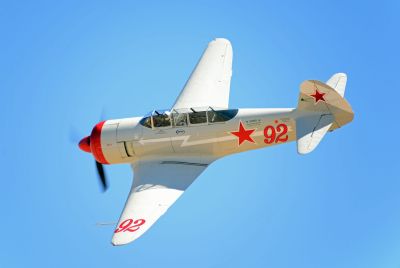 |
| The Pratt & Whitney R-1830-54 powered Yak-11 flown by Dusty Dowd. Fuel mixture issues were a problem requiring he run the engine in Auto-Lean. |
#12 The Rebel, a stock Merlin powered P-51D was qualified by John Currenti at 303.723 mph. John then alternated piloting duties with Doug Matthews, with the pair of them providing strong competition within the group of five stock Mustangs and the Yak-11. On Saturday John gave the Grim Reaper a real chase, finishing the Silver heat in third place, 7.250 seconds behind Grim Reaper with a speed of 346.356 mph. Doug Matthews got the best finish of the week for The Rebel when he finished in second place during Sunday’s Silver heat at 332.828 mph.
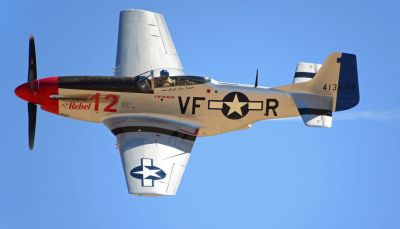 |
| The Rebel, a stock Mustang, in Sunday’s Silver final where Doug Matthews came in second at 332.828 mph. That’s radiator spraybar water trailing the aircraft. |
#81 Lady Jo, a stock P-51D Mustang flown by Rob Gordon was back racing this year. Evidently a little rusty, Rob cut four pylons during the first race on Thursday and was also disqualified for having flown too high. He got it together for the rest of the week, although Lady Jo finished in last place in all of the Silver heats.
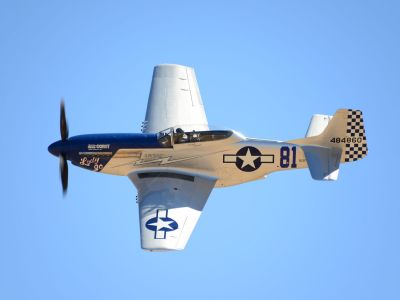 |
| Lady Jo finished in last place all week, but still looked good on the course. |
The Airshow
A major feature of the spectacle that is the Reno Air Race is the accompanying air show. In between race heats a variety of interesting and outstanding performers throw their craft through some amazing maneuvers in the high altitude air. Every year the Airshow brings in a major jet team. This year the event was fortunate to have both Tora, Tora, Tora! Pearl Harbor re-enactors and the Breitling Jet Demo team from Switzerland. The Breitling Jet Demo team was on their first American tour, flying matched L-39C Albatross jets. They are the largest professional civilian jet formation team in the world and put on an amazing and colorful demonstration. Their performances include a number of formations and maneuvers that are not familiar to American audiences, all well executed and performed within the confines of the hills surrounding the race course. Very impressive.
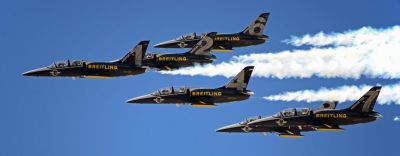 |
| Breitling Jet Team in their L-39C jets performing precision maneuvers at Reno 2015. |
The Other Classes
There is more going on than just the Unlimited class racing at Reno. In fact there are six racing divisions: Unlimited, Jets, Sport, T-6, Formula and Biplane. In total: 119 airplanes this year. With each division typically offering at least two races each day, there are a lot of airplanes in the sky, and a lot of good racing going on.
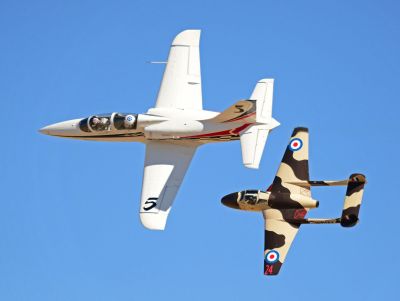 |
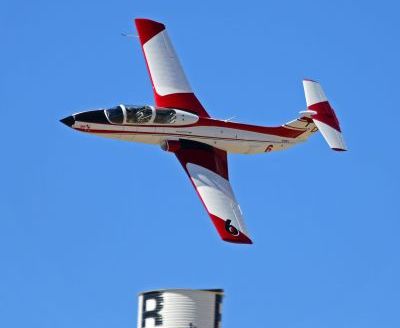 |
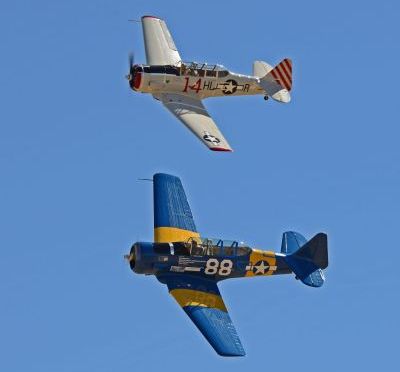 |
| American Spirit #5 being passed by Vampire #24 during the Friday Jet heat. Pete Zaccognino in Vampire won the Sunday Gold jet race at 502.370 mph. | L-29 Sluggo #6 rounding Pylon 8 during Friday’s heat race. Won the Sunday Silver jet heat at 385.743 mph. | T-6s #14 and #88 battling it out at Pylon 2 during the Sunday Gold, won by #43 at 238.073 mph |
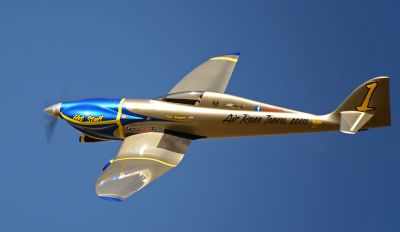 |
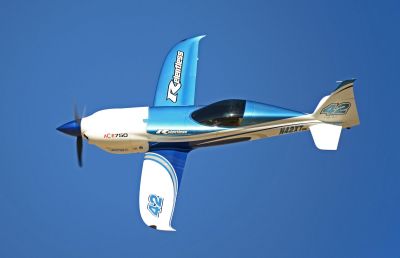 |
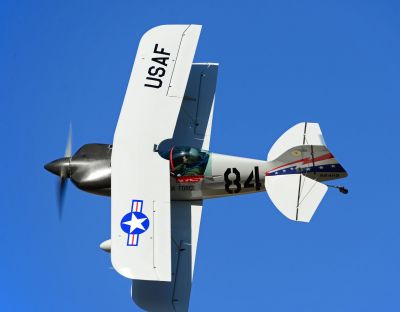 |
| Thom Richard wasn’t able to get his Unlimited Precious Metal to Reno this year, but he performed outstandingly in his Formula racer Hot Stuff, finishing 4th in the Sunday Gold at 231.138 mph. | Kevin Eldredge in Relentless did not have a big engine this year but still managed 310.116 mph in the Sunday Gold Sport Class final. | Biplane racer Panther, #84, is a Pitts S-1S flown by Alan Hoover. Seen here during a Friday heat race. He qualified at 193.684 mph. |
Summary
The 52nd year of classic Reno Air Racing again provided some of the most exciting and competitive racing that we have seen in years. The commitments of the racers and owners again resulted in very competitive races that were exciting for competitors and fans alike. The overseeing Reno Air Racing Association is working hard to continue this unique sporting event and their efforts were obvious to all. Special thanks are due to the hundreds of volunteers who diligently work to not only make the event a success, but to insure that operations are safe, coordinated and timely. They do a fantastic job.
See you at Reno 2016!
